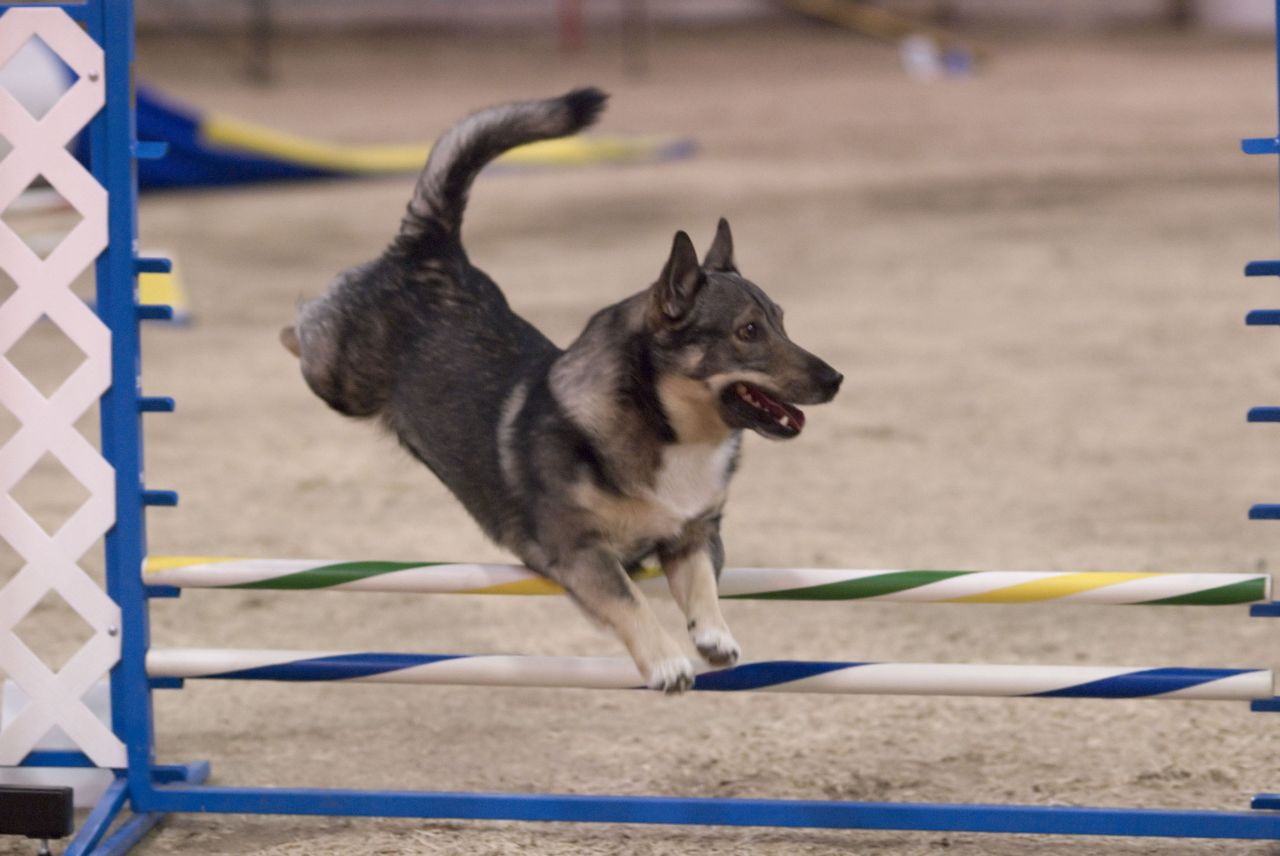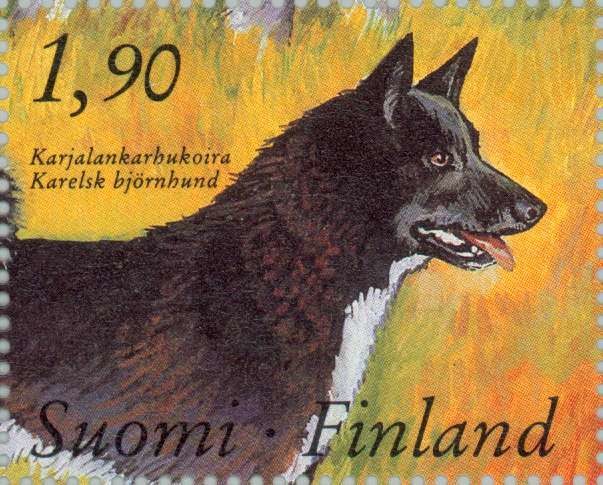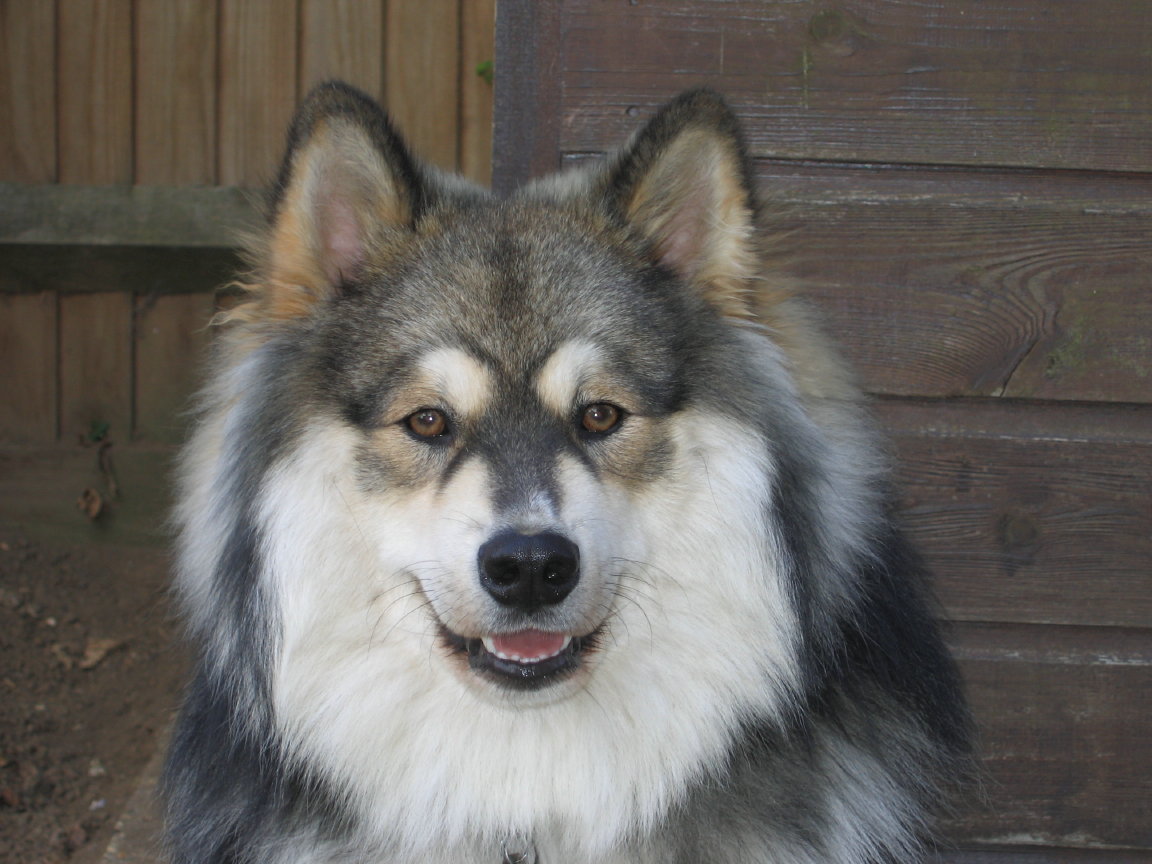|
Black Norwegian Elkhound
The Black Norwegian Elkhound (Norwegian Elghund Sort (NES) in Norwegian) is a small Spitz breed classified by the Fédération Cynologique Internationale, FCI as a hunting dog. It is currently an uncommon breed in Norway and very rare outside the Nordic countries of Scandinavia. It is a sibling breed to a Norwegian Elkhound, Grey Norwegian Elkhound, but is smaller, more agile, doesn't bark and was bred explicitly for on-leash dog hunting. Historically, the Black Norwegian Elkhound has originated from local spitz dog population in the border areas between Norway and Sweden, and has existed as its own breed since the mid-19th century. The breed name "Elkhound" comes directly from its original Norwegian name "Elghund," meaning ""elk dog" or "moose dog." In Norwegian, "elg" refers to the animal English speakers know as an "elk" (in Eurasia) or "moose" (in the United States), and "hund" means "dog." In literature the breed is mentioned by the Englishman Llewelyn Lloyd (naturalist) ... [...More Info...] [...Related Items...] OR: [Wikipedia] [Google] [Baidu] |
Spitz
A spitz (; , in reference to the pointed muzzle) is a Dog type, type of domestic dog consisting of between 50 and 70 breeds depending on classification. There is no precise definition of 'spitz' but typically most spitz breeds have pricked ears, almond shaped eyes, a pointed muzzle, a double coat, and a tail that curves over the back. The exact origins of spitz dogs remain unknown, though most of the spitzes seen today originate from the Arctic region or from Siberia. Johann Friedrich Gmelin described the type as ''Canis pomeranus'' in his 1788 revision of ''Systema Naturae''. Linnaeus, C. (translated and revised by R. Kerr). 1792. ''The Animal Kingdom; or, zoological system of the celebrated Sir Charles Linnaeus. Class I. Mammalia and Class II. Birds. Being a translation of that part of the ''Systema Naturae'', as lately published with great improvements by Professor Gmelin, together with numerous additions from more recent zoological writers and illustrated with copperplates' ... [...More Info...] [...Related Items...] OR: [Wikipedia] [Google] [Baidu] |
Dogs
The dog (''Canis familiaris'' or ''Canis lupus familiaris'') is a domesticated descendant of the gray wolf. Also called the domestic dog, it was selectively bred from a population of wolves during the Late Pleistocene by hunter-gatherers. The dog was the first species to be domesticated by humans, over 14,000 years ago and before the development of agriculture. Due to their long association with humans, dogs have gained the ability to thrive on a starch-rich diet that would be inadequate for other canids. Dogs have been bred for desired behaviors, sensory capabilities, and physical attributes. Dog breeds vary widely in shape, size, and color. They have the same number of bones (with the exception of the tail), powerful jaws that house around 42 teeth, and well-developed senses of smell, hearing, and sight. Compared to humans, dogs possess a superior sense of smell and hearing, but inferior visual acuity. Dogs perform many roles for humans, such as hunting, herding, pu ... [...More Info...] [...Related Items...] OR: [Wikipedia] [Google] [Baidu] |
FCI Breeds
FCI may refer to: Companies and organizations * Falling Creek Ironworks, the first iron production facility in North America * Family Carers Ireland, Irish lobbying group * Fédération cynologique internationale, the Fédération cynologique internationale (International Canine Federation) * Federal Correctional Institution, part of the United States Bureau of Prisons * Fédération Cynologique Internationale, the World Canine Federation * Fertilizer Corporation of India, an Indian government-owned corporation * Fluid Components International, an American manufacturing company * Food Corporation of India, an Indian government-owned corporation * Francis Crick Institute, a British biomedical research centre * Fujisankei Communications International, an American media company Sports * F.C. Indiana, an American soccer team * FC Ingolstadt 04, a German football club * FCI Tallinn, an Estonian football club * Food Corporation of India F.C., an Indian football club * It ... [...More Info...] [...Related Items...] OR: [Wikipedia] [Google] [Baidu] |
Swedish Vallhund
The Swedish Vallhund, also known as the ''Västgötaspets'' and Swedish cow dog, is a Dog breed, breed of dog native to Sweden. The breed's name, ''Vallhund'', when translated into English, means herding dog, as the Swedish Vallhund was originally bred as a Droving, drover and herding dog, herder of cows over 1,000 years ago. In 1942, the dog came close to extinction, but careful breeding and publicity by Swedish national Björn von Rosen and K. G. Zettersten managed to revive the breed in popularity and save it from its likely end. In 1943, the Svenska Kennelklubben, Swedish Kennel Club recognized the Swedish Vallhund as a breed, and officially categorized the Swedish Vallhund as "the Västgötaspets" for Västergötland, the province in which their revival took place. Since then, the breed has been recognized by, and bred in, over ten countries and has gained some popularity. Physical features The average height of the Swedish Vallhund, measured at the withers, is approx ... [...More Info...] [...Related Items...] OR: [Wikipedia] [Google] [Baidu] |
Swedish Lapphund
The Swedish Lapphund () is a breed of dog of the Spitz type from Sweden, one of three ''Lapphund'' breeds developed from a type of dog used by the Sami people for herding and guarding their reindeer. The expression "the black beauty of Norrland" is very often attributed to the Swedish lapphund, which is most likely one of Sweden's oldest breeds. Lineage The breed falls under the mitochondrial DNA sub-clade referred to as d1 that is only found in northern Scandinavia. It is the result of a female wolf-male dog hybridization that occurred post-domestication. Subclade d1 originated "at most 480–3,000 years ago" and is found in all Sami-related breeds: Finnish Lapphund, Swedish Lapphund, Lapponian Herder, Jamthund, Norwegian Elkhound and Hällefors Elkhound. The maternal wolf sequence that contributed to these breeds has not been matched across Eurasia and its branch on the phylogenetic tree is rooted in the same sequence as the 33,000 year-old Altai dog (not a direct ancestor). ... [...More Info...] [...Related Items...] OR: [Wikipedia] [Google] [Baidu] |
Jämthund
The Jämthund, also called the Swedish Elkhound, is a Dog breed, breed of dog of the Spitz Dog type, type that is found in Northern Europe. The Jämthund is eponymous with Jämtland, a province in the middle of Sweden. History The Jämthund is one of a number of breeds of spitz-type hunting dogs that have been known throughout Scandinavia for centuries. Historically these dogs have been used to hunt a wide variety of game including Eurasian brown bear, bear, Moose, elk, Eurasian wolf, wolf and Eurasian lynx, lynx. The Jämthund received official recognition as a breed in 1946, due to intensive work by Aksel Lindström and others. Before that, both it and the Norwegian Elkhound were seen as the same breed. They are both used for hunting large game, such as moose and bear. Lineage The breed falls under the mitochondrial DNA sub-clade referred to as d1 that is only found in northern Scandinavia. It is the result of a male dog-female wolf hybridization that occurred post-domesticati ... [...More Info...] [...Related Items...] OR: [Wikipedia] [Google] [Baidu] |
Norwegian Lundehund
The Norwegian Lundehund (Norwegian: ''Norsk lundehund'') is a small dog breed of the Spitz type that originates from Norway. Its name is a compound noun composed of the elements ''lunde'', meaning puffin (Norwegian ''lunde'', "puffin", or ''lundefugl'', "puffin bird"), and ''hund'', meaning dog. The breed was originally developed for the hunting of puffins and their eggs on inaccessible nesting places in caves and on cliffs. The breed was at the brink of extinction in the 1960s and preservation efforts have since been underway. History The Lundehund was a valuable working animal for hunting puffin birds along the Norwegian coast as food for over 400 years. The first known written record of the breed dates to 1591, when a bailiff wrote of his visit to Værøy that, “one cannot easily retrieve [puffins] from the depth without having a small dog accustomed to crawling into the hole and pulling the birds out.” Its flexibility and extra toes were ideal for hunting the birds in th ... [...More Info...] [...Related Items...] OR: [Wikipedia] [Google] [Baidu] |
Norwegian Buhund
The Norwegian Buhund () is a breed of dog of the spitz type. It is closely related to the Icelandic Sheepdog and the Jämthund. The Buhund is used as a watch dog and an all purpose farm and herding dog. Description General appearance The Norwegian Buhund has a square profile, is a little under medium-sized and sports a high set, tightly curled tail carried over the center of the back. The head is wedge shaped with pricked ears and a black nose. Their back is level with a deep chest. Measurements The Buhund ranges in size from about 43 to 45 centimeter (17 to 18 inches) with the males being 43–46 cm (17-18 in) and females to 44 cm(17 in) high. The weight range is 14–18 kg (31–40 pounds) for males and 12–16 kg (26–35 pounds) for females. Coat Wheaten – Any shade from pale cream to bright orange, with or without dark tipped hairs; as little white as possible; black mask acceptable. Black – Preferably without too much bronzing; with as little ... [...More Info...] [...Related Items...] OR: [Wikipedia] [Google] [Baidu] |
Karelian Bear Dog
The Karelian Bear Dog ( ) is a Finland, Finnish dog breed, breed of dog. In its home country, it is seen by many as a national treasure. Karelian Bear Dogs will hunt a variety of animals. Its quick reflexes and fearless nature have made it very popular for hunting large game including brown bears, moose, and wild boar. It was the breed's ability to hunt bears that earned the breed its name. The Karelian Bear Dog is among the top 10 most common dog breeds in Finland. History The Karelian Bear Dog originated from the Komi dog. Basic stock dogs originated from the Ladoga Karelia, Olonets Karelia, and East Karelia where they were used for hunting. The breeding was started in 1936 to create a sturdy dog which would bark at big game, and named the Karelian Bear Dog. The first standard was established in 1945 and the first dogs were registered in 1946. The Karelian Bear Dog was used mainly for hunting small fur-bearing animals, such as squirrels and marten. Like the Norwegian Elkhound, ... [...More Info...] [...Related Items...] OR: [Wikipedia] [Google] [Baidu] |
Finnish Lapphund
The Finnish Lapphund (or Finnish Lapponian Dog) ( ) is a hardy, easy going, medium-size dog breed, breed of Spitz type. Traditionally it has been used for herding reindeer. Although it is one of the most popular dog breeds in its native country, Finland, it is not very numerous outside of the Nordic countries. Lineage The breed falls under the mitochondrial DNA sub-clade referred to as d1 that is only found in northern Scandinavia. It is the result of a female wolf-male dog hybridization that occurred post-domestication. Subclade d1 originated "at most 480–3,000 years ago" and is found in all Sami people, Sami-related breeds: Finnish Lapphund, Swedish Lapphund, Lapponian Herder, Jamthund, Norwegian Elkhound and Hällefors Elkhound. The maternal wolf sequence that contributed to these breeds has not been matched across Eurasia and its branch on the phylogenetic tree is rooted in the same sequence as the 33,000 year-old Paleolithic dog#Altai dog – 33,000 BP, Altai dog (n ... [...More Info...] [...Related Items...] OR: [Wikipedia] [Google] [Baidu] |
List Of Dog Breeds
This list of dog breeds includes both Neontology#Extant taxa versus extinct taxa, extant and extinct dog breeds, Designer breed, varieties and dog type, types. A research article on dog genomics published in Science/AAAS defines modern dog breeds as "a recent invention defined by conformation to a physical ideal and purity of lineage". According to BigThink, over 40% of the world's dog breeds come from the United Kingdom, France and Germany. It states: "Great Britain and France are the ground zero of dog fancying, with 57 registered breeds each. Germany is not far behind, with 47 breeds. These three countries alone represent more than 40% of all dog breeds recognized by the Fédération Cynologique Internationale." Extant breeds, varieties and types A–C D–K L–R S–Z Extinct and critically endangered breeds, varieties and types See also * Dog type * List of dog crossbreeds * List of Italian dog breeds * List of dog breeds from India * List of Tibetan d ... [...More Info...] [...Related Items...] OR: [Wikipedia] [Google] [Baidu] |
Hip Dysplasia (canine)
In dogs, hip dysplasia is an abnormal formation of the hip socket that, in its more severe form, can eventually cause lameness and arthritis of the joints. It is a genetic (polygenic) trait that is affected by environmental factors. It is common in many dog breeds, particularly the larger breeds, and is the most common single cause of arthritis of the hips. Overview Normal hip anatomy In the normal anatomy of the hip joint, the almost spherical end of the femur head (the caput, or caput ossis femoris) fits into the acetabulum (a concave socket located in the pelvis). The bony surfaces of the femur head and of the acetabulum are covered by cartilage. While bones provide the strength necessary to support body weight, cartilage ensures a smooth fit and a wide range of motion. Normal hip function can be affected by congenital conditions such as dysplasia, trauma, and by acquired diseases such as osteoarthritis and rheumatoid arthritis. Dysplastic hip anatomy The hip could have ... [...More Info...] [...Related Items...] OR: [Wikipedia] [Google] [Baidu] |





